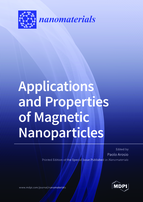Applications and Properties of Magnetic Nanoparticles
A special issue of Nanomaterials (ISSN 2079-4991). This special issue belongs to the section "Inorganic Materials and Metal-Organic Frameworks".
Deadline for manuscript submissions: closed (5 April 2021) | Viewed by 59436
Special Issue Editor
Interests: magnetic multifunctional nanoparticles; molecular magnets; low-dimensional magnetic clusters; magnetic highly-sensitive biosensors; nuclear magnetic resonance; magnetic resonance imaging; applications of NMR in cultural heritage; magnetometry
Special Issues, Collections and Topics in MDPI journals
Special Issue Information
Dear Colleagues,
It is well-known that nanomaterials are a key focus of research for wide outspread novel applications. As the size decreases to the nano-scale, the properties of materials greatly change owing to their large surface-to-volume ratio, quantum size effects and electrodynamic interactions. In the last decades a lot of research has been carried out for the synthesis, characterization and modellization of nanostructured materials for several applications, ranging from electronics and energy harvesting and storage, to biomedical applications.
In this special issue, I cordially invite front-line researchers with an interdisciplinary approach to submit original articles on exploring the use of magnetic nano-objects in a broad range of applications.
For this purpose, the Issue wants to cover the new developments in the synthesis and characterization of magnetic nanoconstructs ranging from conventional metal oxides nanoparticles to novel molecule-based or hybrid multifunctional nano-objects. At the same time, this Special Issue is intended to focus on and explore the potential of these novel magnetic nanoconstructs in Nanomedicine and Biology, in energy harvesting and storage applications, in sensing applications, in pollution remediation, in data storage and several other possible applications.
Dr. Paolo Arosio
Guest Editor
Manuscript Submission Information
Manuscripts should be submitted online at www.mdpi.com by registering and logging in to this website. Once you are registered, click here to go to the submission form. Manuscripts can be submitted until the deadline. All submissions that pass pre-check are peer-reviewed. Accepted papers will be published continuously in the journal (as soon as accepted) and will be listed together on the special issue website. Research articles, review articles as well as short communications are invited. For planned papers, a title and short abstract (about 100 words) can be sent to the Editorial Office for announcement on this website.
Submitted manuscripts should not have been published previously, nor be under consideration for publication elsewhere (except conference proceedings papers). All manuscripts are thoroughly refereed through a single-blind peer-review process. A guide for authors and other relevant information for submission of manuscripts is available on the Instructions for Authors page. Nanomaterials is an international peer-reviewed open access semimonthly journal published by MDPI.
Please visit the Instructions for Authors page before submitting a manuscript. The Article Processing Charge (APC) for publication in this open access journal is 2900 CHF (Swiss Francs). Submitted papers should be well formatted and use good English. Authors may use MDPI's English editing service prior to publication or during author revisions.
Keywords
- magnetic nanoparticles
- magnetic hybrid nanomaterials
- nanomagnetism
- magnetic nanocomposite
- multifunctional magnetic nanoparticles
- novel applications of magnetic nanomaterials







